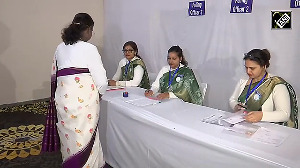The one with the curious name is the runaway leader, setting benchmarks in programming, standardisation and localisation. It doesn't hurt to be part of a formidable family.
It was an awkward moment, recalls A P Parigi, the managing director of Entertainment Network India Limited (ENIL). The year was 2001 and ENIL, the Times Group radio company, had just launched its first radio station in Indore.
"At the launch, people were congratulating me as the CEO for the brand name of Radio Mirchi. It was embarrassing because the name was given by Times group managing director Vineet Jain in the face of stiff opposition from the rest of us."
Parigi, who has moved to a bigger role in the organisation -- he's on the ENIL and Bennett, Coleman & Co boards and manages key investments for the group -- confesses that nobody in the radio team was convinced about the branding "which, surprisingly, had an instant connect in Indore".
But Radio Mirchi also enjoyed the first mover advantage in the private FM radio category.
Last fortnight, ENIL declared its financial results for the year 2007-08. The Radio Mirchi part of ENIL's business (it also has events, out-of-home media and films) generated a profit of Rs 57 crore (Rs 570 million) on revenues of Rs 229 crore (Rs 2.29 billion).
Apurva Purohit, the CEO of rival Radio City, is not very impressed. "It depends on how you define profitability," she says. "FM networks have ventured into new markets."
Some others, though, are ready to applaud the financial performance of ENIL, which was listed in February 2006. "Almost all other stations must still be losing money," says Manajit Ghoshal, chief financial officer, Mid-Day Multi Media, which operates six radio stations.
The bottom line is shored up by the 48 per cent share of the private radio market that Mirchi's 32 stations have garnered. Says radio consultant Sunil Kumar: "The company understood the Indian audiences like no one else
did. It created a mass product that was copied by others. It got the right mix of content standardisation and localisation for its stations. Lastly, the company managed to retain its top talent."
Shedding baggage
Parigi, when he was the CEO, decided to build a team consisting executives without any media experience. He himself sauntered into Radio Mirchi in 2,000 fresh from building the mobile phone brand of BPL. Prashant Panday, the current CEO, came from cosmetics maker Revlon.
"We did not want people with domain knowledge because we wanted new concepts," says Panday.
The offices were given a campus feel with the use of bright reds and greens. "We encouraged a chilled out attitude. The noise and energy levels in the office are high and we work hard to maintain that," says Panday.
While Radio Mirchi may be 'hot', its attitude towards people is 'cool'. It threw a party to cheer up about 100 people who were interviewed but didn't get selected as radio jockeys. Those selected were thrown into rigorous training.
In 2007, when 22 stations were to be set up, Mirchi set up a training academy within MICA, Mudra's advertising institute.
With job rotation, promotions and training, the company has managed to keep its top talent intact. When two creative heads were at loggerheads recently, they were locked into a room for a day to sort out their problems.
Of the top 120 people (out of the total 880) barely four or five have quit. "Even the overall attrition rate in the company is 10 per cent compared to the industry norm of 40 per cent. A stable brass guarantees consistency in policies -- human resources, programming and marketing," says Panday.
Pieces of jigsaw
At Mirchi, the marketing decides how the brand needs to be developed and its findings form the basis of programming. The demographics of a city that Mirchi enters are first analysed by the marketing team. "We need to know the language of the music in that place and its language of communication," says Tapas Sen, chief programming officer.
His belief, borne out by market research, is that people like to hear radio in the language they think in. "We arrive at a conclusion through market research and focus group studies. We are strong on market genetic coding," says Sen, sounding more like a marketer than a programming head.
But the marketing may err. For its nine stations in the south, the choice of language for music and communication was clear; it had to be local.
However, Bangalore confused them. The Kannada speaking RJs played Bollywood hits which failed to impress the listeners. Mirchi quickly switched to Kannada music to become the number one channel in the city.
Sen insists that research is a good indicator of a market. The marketing team told Mirchi to keep Marathi-speaking RJs for Pune but Hindi-speaking ones in Nagpur.
"Though located in Maharashtra, Nagpur consumes its media in Hindi."
Clearly, Mirchi maintains a balance between localisation and standardisation of content. New or contemporary popular music is what Mirchi plays across all its stations. In the north, the music is Hindi.
"We don't play ghazals and bhajans in Indore and Bollywood superhits in Mumbai. The brand promise remains the same across channels," says Panday.
Localisation involves the use of local music, language, RJs and respect for the native culture. "If the station is in Indore, the listeners must feel that the MD of the company sits in Indore and not in New Delhi," says Sen.
Even rival channels admire Mirchi's non-music interludes, especially its sparklers -- a name developed in-house for the characters created to interact with listeners. The promoter of a radio station in Delhi says Mirchi has managed to establish a distinct brand identity and brand connect even as it plays the same music.
The channel's jingle was composed by hit Bollywood pair Vishal-Shekhar and its television commercial, Mirchi
sun ne wale always khush, was the handiwork of well-known ad man Prasoon Joshi.
Sibling support
Critics argue that if you belong to India's number one print media company, as Mirchi does, brand connect is not hard to achieve. "It has cross-leveraged its media properties very effectively to promote Mirchi," says Mid-Day's Ghoshal.
In the initial years, it advertised extensively in The Times of India. The brand often found a place in the newspaper's city supplements, according to the head of a radio station who does not wish to be identified.
Panday says Mirchi always paid for ad space in ToI. Even now, Times' out-of-home division has the rights to the outdoors for the Mumbai airport, which is leveraged by Mirchi.
"Brand connect comes easily if a company has Rs 30-40 crore (Rs 300-400 million) to burn in marketing," complains a radio industry rival. However, a media observer says that if money alone was the key to brand connect, Reliance' Big FM would have beaten Mirchi.
While humour is the key at Mirchi, the brief to RJs is that they should be able to make their listeners cry. "That's the acid test. Radio is a very emotional medium," says Sen.
He says the RJs must know their cities like the back of their hand. "It would help if they knew the colour of uniforms of the city's schools."
Mirchi is active in events as well. In Delhi, it spearheaded the candlelight vigil for justice for Jessica Lal, the woman who was murdered by a politician's son. "We've even done things like celebrating rakhi in Tihar jail," says Sen.
Challenges ahead
As is the fate of every leader, Mirchi has to contend with constantly rising competition. The first body blow has been already delivered by Radio City, which, according to TAM's Radio Audience Measurement, has usurped the leadership in Mumbai. Purohit claims that her FM stations are also leading in Lucknow and Bangalore according to some surveys.
Sourcing of talent for radio will be a big concern, says KPMG's media practice head Rajesh Jain. Mirchi needs another 100 people soon. Owing to the shortage, the cost of manpower is shooting up.
"Moreover, all the stations sound the same. There's a need to move towards content differentiation as well," says Jain. For that, the government needs to allot a player multiple stations in the same city. Of course, the competition from Internet and satellite radio will only grow.
Although industry bodies have predicted 60 per cent growth for radio, the actual numbers so far have been barely half of that. In a thoughtful mood, Parigi says investor conferences each quarter throw up questions on costs, manpower and other challenges. At least in this case, the standard and local concerns are the same: to ensure that Mirchi stays hot.
The sparklers
If you live in any of the 23 cities where Radio Mirchi has a Hindi station, you couldn't have missed Sudarshan, who insists that people call him "Sud". One of the most popular characters on radio, Sud reads out the poorest of PJs in the flattest of tones followed by queer comments and laughter.
"Mothers come with their kids to meet Sud," says Tapas Sen, chief programming officer, Radio Mirchi. In Mirchi lingo, Sud is a sparkler, a character that endears a station to its listeners.
"It also offers the opportunity to spoof or trip the locals. For instance, through Gogo Ganguli in Kolkata, the station laughs at the idiosyncrasies of Bengalis. When a local is laughing at you, you don't mind, as he's part of you," says Sen.
Mirchi started the trend with Professor Kavas, the Parsi who, across seven stations, made mimics masquerading as actors recite nursery rhymes. Other stations have been quick to replicate and sparkler has become a part of the industry's jargon. A sparkler's identity is always kept secret.
"We want it to be the theatre of the mind," says Sen.







 © 2025
© 2025